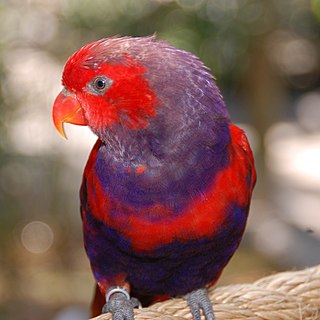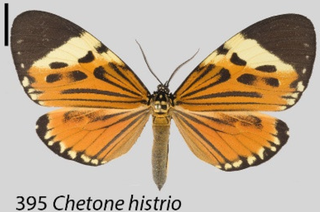
The sargassum fish, anglerfish, or frog fish is a frogfish of the family Antennariidae, the only species in its genus. It lives among Sargassum seaweed which floats in subtropical oceans. The scientific name comes from the Latin histrio meaning a stage player or actor, and refers to the fish's feeding behaviour.

Latridiidae is a family of tiny, little-known beetles commonly called minute brown scavenger beetles or fungus beetle. The number of described species currently stands at around 1050 in 29 genera but the number of species is undoubtedly much higher than this and increases each time a new estimate is made.

Dosinia is a genus of saltwater clams, marine bivalve molluscs in the family Veneridae, subfamily Dosiniinae Deshayes, 1853. The shell of Dosinia species is disc-like in shape, usually white, and therefore is reminiscent of the shells of Lucinid bivalves.

The red-and-blue lory is a small, strikingly-colored parrot endemic to Indonesia. The species inhabits a single island, Karakelong, in the Indonesian archipelago, although it was formerly found on the Sangihe Islands and other parts of the Talaud Islands.

Stereocyclops histrio is a species of frog in the family Microhylidae. It is endemic to the northeastern Bahia state of Brazil where it occurs in remnants of the Atlantic forest. After the holotype was collected in 1944, the species went unrecorded until a population was found in the Una Biological Reserve and its surroundings in 1999. It is now known from four locations. Common name Bahia yellow frog has been coined for it, perhaps in reference to the bright lemon yellow coloration of the holotype. It was the only species in the genus Hyophryne until 2012 when molecular data demonstrated that it is nested within Stereocyclops species.

Eos is a genus of parrots belonging to the lories and lorikeets tribe of the family Psittaculidae. There are six species which are all endemic to islands of eastern Indonesia, most within very restricted ranges. They have predominantly red plumage with blue, purple or black markings. Males and females are similar in appearance.

Gobiodon histrio, the Broad-barred goby, is a species of goby native to the Indian Ocean from the Red Sea to the western Pacific Ocean to southern Japan, Samoa and the Great Barrier Reef. This species is a reef dweller, being found at depths of from 2 to 15 metres. It can reach a length of 3.5 centimetres (1.4 in) TL. This species can also be found in the aquarium trade.
Terebra histrio is a species of sea snail, a marine gastropod mollusc in the family Terebridae, the auger snails.

Mauritia histrio, common name the harlequin cowry or the stage cowry, is a species of sea snail, a cowry, a marine gastropod mollusk in the family Cypraeidae, the cowries.
Latridiinae is a subfamily of tiny, little-known beetles in the family Latridiidae.

Aglaomorpha histrio is a moth of the family Erebidae first described by Francis Walker in 1855. It is found in Korea, Japan, China and Taiwan.

Enicmus is a genus of beetles in the family Latridiidae, the minute brown scavenger beetles.
Anapisa histrio is a moth of the family Erebidae. It was described by Sergius G. Kiriakoff in 1963. It is found in Angola, the Democratic Republic of the Congo and Kenya.
The Slow goby is a species of goby fish endemic to the Gulf of California on the west coast of North America. It inhabits crevices in rocks and can be found in tide pools down to a depth of around 14 metres (46 ft). This species grows to a maximum length of 6.5 centimetres (2.6 in) SL. This species is the only known member of its genus.

Chetone histrio, or Boisduval's tiger, is a moth of the family Erebidae. It was described by Jean Baptiste Boisduval in 1870. It is found in Honduras, Guatemala and Peru. The habitat consists of rainforests and cloudforests at elevations between 500 and 2,000 meters on the eastern slopes of the Andes.

Iris histrio, the Syrian iris, is a species in the genus Iris, it is classified in the subgenus Hermodactyloides and section Reticulatae. It is a bulbous perennial from Central Asia: Kyrgyzstan, Israel, Lebanon, Syria and southern Turkey.
Thyreus histrio, is a species of bee belonging to the family Apidae subfamily Apinae.

Pamphilius histrio is a species of leaf-rolling sawflies within the Symphyta belonging to the family Pamphiliidae.
Rhysodromus histrio is a species of spiders in the family Philodromidae. It is the type species of its genus. It is found in North America, Europe, Turkey, Caucasus, Russia (Sibiria), Central Asia and China.

Parancistrocerus histrio is a species of stinging wasp in the family Vespidae.













